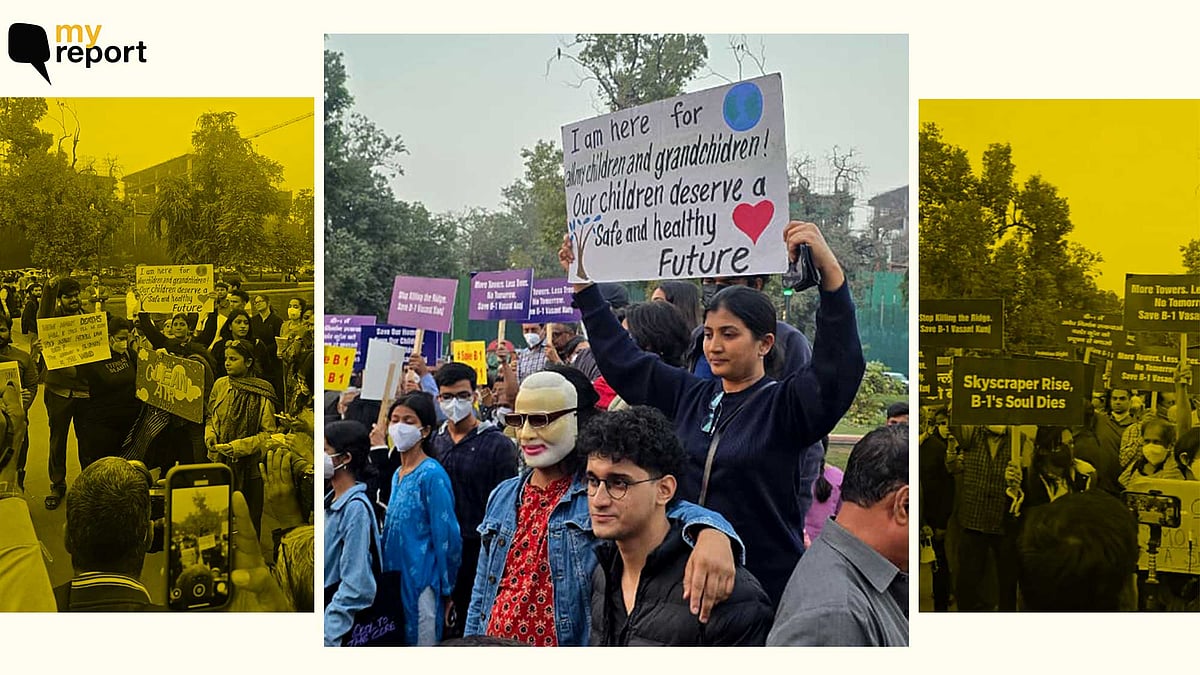'I Protested at India Gate as Delhi’s Air Kills Us. Yet, Govt Shows No Urgency'
I joined the protests on 10 November because we’re literally running out of breath, writes a protester.

advertisement
I went to New Delhi's India Gate on the evening of 10 November because I could not stand by any longer.
For weeks, the air in Delhi has been a slow, choking assault, and a daily attack on my family. People with asthma and other respiratory issues in my household are getting worse.
I could see the toll it was taking on them: constant coughing, waking up with tight chests, and an anxiety that comes from not knowing whether today’s air will leave you breathless. That’s what pushed me onto the streets.
We Marched for Our Rights
According to police, several protesters at the site were detained for assembling without permission.
The Deputy Commissioner of Delhi Police, Devesh Kumar Mahla said the detentions were preventive. "Only Jantar Mantar is designated as a protest site where permission can be sought by following due procedure," he was quoted as saying by PTI.
When the state fails to protect this right, when it treats toxic air as something we should simply adapt to, citizens have every reason to protest peacefully. Article 19 protects our right to assemble and speak, so long as we don’t create a nuisance.
We had planned the march where there’s no vehicle movement precisely to avoid any nuisance. This wasn’t about disruption; it was about urgency.
We reached the India Gate a little before 5 pm. Hundreds of people had gathered—students, parents, seniors, and doctors—all worried about the same thing. We started marching to make a visible demand: that the government treat this as what it is: a public health emergency.
But the march was halted. Officials told us a magistrate had issued an order under Section 163, instructing us not to protest there. Then they rounded people up. I found this deeply wrong — not because we wanted to cause trouble, but because we were exercising our fundamental rights to demand the basic conditions for life.
An Issue That Runs Deeper Than Political Cycles
This isn’t a matter of blame-shifting between one election and the next. It’s about coordinated state action. Stubble burning in Punjab and Haryana does contribute to Delhi’s pollution, particularly in the months of October and November, but it isn’t the whole story.
I keep thinking about how other cities have responded when smog became intolerable. When Beijing faced its infamous smog crisis in the 2010s, the Chinese government declared red alerts, shut down factories, converted coal plants to gas, restricted vehicle licenses, and coordinated policy implementation across provinces.
Over a span of a decade, they cut PM2.5 levels by more than 50 percent, from nearly 90 µg/m³ in 2013 to around 30 µg/m³ today. It wasn’t easy, but it showed what political will and regional coordination can achieve.
Similarly, Paris took a bold urban approach. The city banned older vehicles, created low-emission zones, expanded cycling and pedestrian infrastructure, and even made public transport free during high-pollution days.
In the last decade, Paris cut nitrogen dioxide levels by about 45 percent and fine particulate levels by 35 percent. Even though their air still doesn’t meet WHO standards fully, they’ve demonstrated consistent progress through sustained, city-wide measures.
If Not the State, Then Who Do We Hold Accountable?
There are practical steps the state can and must take:
Declare severe pollution a public health emergency and bring it under the disaster management framework so that other agencies act accordingly;
Restrict non-essential vehicle movement during peaks;
Suspend construction and heavy-duty vehicle movement when required;
Expand and prioritise public transport;
Enforce stricter emissions regulations; and
Invest in real-time monitoring and transparent data so citizens can see what’s happening.
For agricultural contributors, subsidies and financial incentives for residue management machines and biowaste systems are essential. One can’t simply expect farmers to change overnight without a transition plan.
Yes, public participation matters. People should use public transport when possible, avoid burning waste, and support local clean-air initiatives. But individual choices can only scratch the surface of the problem.
The air pollution crisis in Delhi is a catastrophe unfolding in slow motion. That night at India Gate, I felt a mixture of anger and resolve. Anger at the indifference of ministers and administrators who do not want to call a crisis a crisis, and resolve because citizens cannot keep waiting.
Protesting was never about confrontation; it was about demanding that the state fulfil its primary duty: protecting the right to life. If we cannot breathe safely, what else matters?
(The Quint has reached out to the Chief Minister of Delhi, the Environment Minister of Delhi, the Department of Environment (Government of NCT of Delhi), and the Delhi Pollution Control Committee for a response to the issues raised. Their responses are awaited, and this story will be updated once we receive them.)
(Abhishek Rana is a Professor of Law at OP Jindal Global University and an expert in environmental law.)
(All 'My Report' branded stories are submitted by citizen journalists to The Quint. Though The Quint inquires into the claims/allegations from all parties before publishing, the report and the views expressed above are the citizen journalist's own. The Quint neither endorses, nor is responsible for the same.)